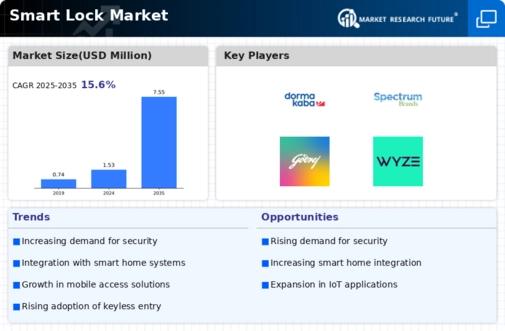Market Trends
Key Emerging Trends in the Smart Lock Market
The Smart Lock market is witnessing several noteworthy trends that are reshaping the industry and influencing consumer preferences. One prominent trend is the increasing integration of artificial intelligence (AI) and machine learning in smart lock systems. AI-powered smart locks can learn user behavior, adapt to routines, and enhance security measures, providing a more personalized and proactive approach to access control. As AI continues to advance, this trend is likely to redefine the capabilities and functionalities of smart locks, making them more intuitive and efficient.
Biometric authentication is another key trend driving the Smart Lock market. Fingerprint recognition, facial recognition, and even iris scanning are becoming popular methods for securing access to smart locks. These biometric technologies offer enhanced security and user convenience, eliminating the need for traditional keys or PIN codes. The trend towards biometric authentication aligns with the broader industry focus on robust security solutions and reflects the increasing demand for advanced, user-friendly access control mechanisms.
The emergence of smart doorbell integration is shaping the Smart Lock market as well. Smart locks are now often designed to work seamlessly with smart doorbell cameras, allowing users to see and communicate with visitors remotely. This integration enhances overall home security and provides users with the ability to remotely grant access to trusted individuals. The trend towards combining smart locks with other home automation devices contributes to the creation of comprehensive and interconnected smart home ecosystems.
Wireless connectivity is a prevailing trend in the Smart Lock market, with many devices adopting technologies like Bluetooth, Wi-Fi, and Zigbee. These wireless connections enable remote monitoring and control through smartphones or other connected devices. The convenience of managing access from anywhere, coupled with the rise of the Internet of Things (IoT), is propelling the adoption of wireless connectivity in smart locks. This trend not only enhances user convenience but also contributes to the overall expansion of smart home ecosystems.
Aesthetic design and product customization are gaining prominence as significant trends in the Smart Lock market. Manufacturers are increasingly focusing on creating smart locks that not only provide high-tech security features but also complement the aesthetic preferences of homeowners. Sleek and modern designs, along with customizable finishes, are becoming key selling points. This trend reflects a growing awareness of smart locks as not just utilitarian devices but as integral elements of home decor.
Subscription-based models for smart lock services are emerging as a trend that complements the traditional product sales approach. Some companies offer additional services such as remote monitoring, activity alerts, and integration with professional security monitoring services through subscription plans. This trend provides an ongoing revenue stream for manufacturers while offering consumers the option to enhance the functionality of their smart locks with additional services.
Environmental sustainability is becoming a notable trend in the Smart Lock market. Manufacturers are increasingly focusing on designing energy-efficient devices with minimal environmental impact. This includes the use of eco-friendly materials, energy-efficient components, and adherence to sustainability practices in the production process. As environmental consciousness grows among consumers, this trend is likely to influence purchasing decisions and shape the product strategies of smart lock manufacturers.







Leave a Comment